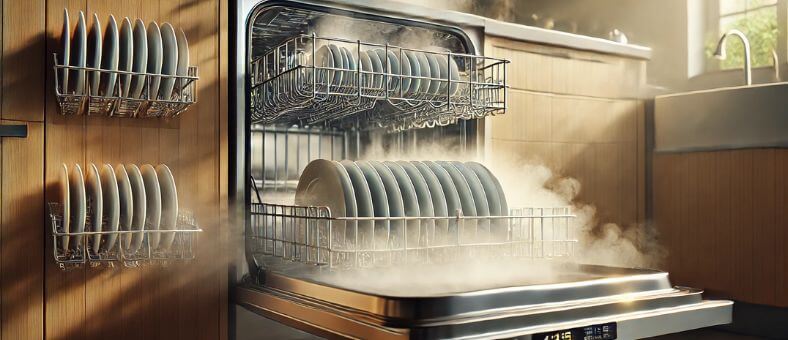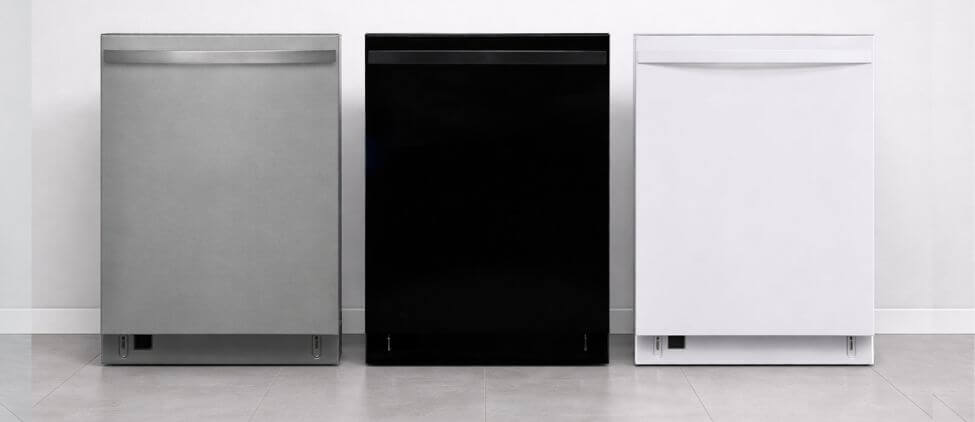Have you ever stood before a sink full of dirty dishes and pondered, “Is there a superior method?” The age-old debate of Dishwasher vs. Hand Washing surfaces, echoing through the walls of modern kitchens everywhere. This seemingly straightforward question ventures into the intricacies of efficiency, environmental stewardship, and our individual lifestyle inclinations.
Despite the advancements in technology and the ever-growing popularity of dishwashers, the classic hand washing method still holds a special place in many households. But why? What makes one method potentially better than the other?
Whichever side of the debate you lean towards, or if you’re still undecided, this is your moment of clarity. You’re about to embark on a journey that weighs the pros and cons, offering a clearer perspective. And by the journey’s end, we aim not only to inform but also to guide your decision in a way that aligns seamlessly with your ethos and daily life. Are you ready to dive deep and discover the better choice? Let’s get started!
Did you know?
In the 1850s, Joel Houghton patented a hand-powered wooden device that splashed water on dishes, marking the birth of the dishwasher. Only around the 1950s did the more modern, reliable, and automatic dishwashers become popular in households.
Table of Contents
Understanding the Process of a Dishwasher
Using a dishwasher may seem straightforward – load the dishes, add detergent, select the cycle, and press start. However, the inner workings of this handy appliance are fascinating. It starts with pre-rinsing the dishes with hot water, followed by an intense wash with highly pressurized hot water and detergent. Post this, another rinse ensures no soap remains on the dishes. Finally, the drying phase uses heat or ventilated air to dry the dishes.
The Traditional Art of Hand-Washing Dishes
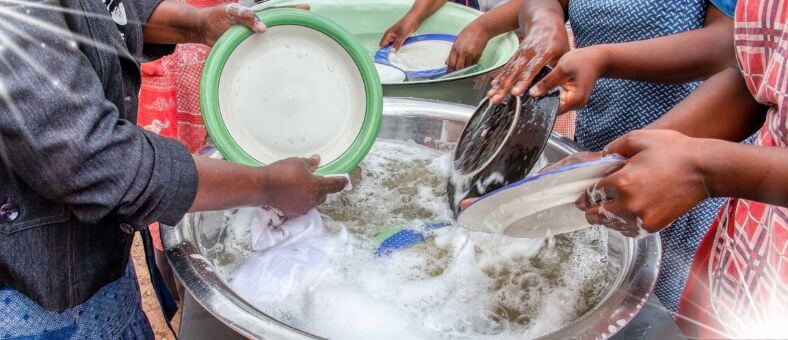
Hand-washing dishes is an age-old practice. The typical process involves pre-rinsing the dishes, filling the sink with hot, soapy water, soaking tough stains, scrubbing the dishes clean, rinsing them under running water, and then drying them with a towel or air drying. Although time-consuming and labor-intensive, hand washing gives you control over stubborn stains and allows immediate usage of washed items. It’s also a better method for delicate items that may not withstand the harsh dishwasher process.
Fun Fact
Studies have shown that dishwashing can provide a sense of mindfulness and stress relief. Immersing your hands in warm water and performing a simple, repetitive task can help calm the mind.
Comparing Water Consumption: Dishwasher vs Hand Washing
Regarding water consumption, modern dishwashers typically use less water than hand washing. An Energy Star-certified dishwasher can use as little as 3 gallons per load. In contrast, hand washing can use up to 27 gallons for the same number of dishes. However, remember that this can vary depending on your dishwasher model and hand-washing habits.
Expert Insight
If you opt for hand washing, try the two-basin method – one basin for washing and one for rinsing – to reduce water usage. Additionally, turning off the tap while scrubbing dishes can save a significant amount of water.
Energy Efficiency: Electric Dishwashers and Hand Washing
On the surface, hand washing uses less energy since it doesn’t require electricity. However, the energy needed to heat the water for hand washing can surpass that of a dishwasher. Modern dishwashers are designed to be energy-efficient and use hot water more effectively. So, from an energy standpoint, dishwashers often have the upper hand.
Regardless of your chosen method, using it efficiently can significantly affect water and energy consumption. Every little step counts towards a greener planet.
Drying Decisions: Dish Rack Versus Dishwasher Drying
Drying is the step that concludes the dishwashing process. Yet, it’s often overlooked in the grand scheme of the dishwasher vs. hand washing debate. Both methods have their unique advantages and considerations.
Dish Racks

Opting for a dish rack after hand washing is a classic choice. Air drying on a dish rack is energy-efficient, relying on the simple principle of evaporation. There’s no electricity consumption, and it can be seen as an eco-friendly approach. Moreover, it allows dishes to dry without the risk of towel lint or potential cross-contamination from hand drying. However, it’s worth noting that dishes on a rack can take up counter space and may need more time to dry thoroughly.
Dishwasher Drying
Modern dishwashers typically use a drying mechanism, usually heat or a fan. This built-in drying process can be remarkably efficient, drying dishes in a fraction of the time it might take on a traditional dish rack. The closed environment can also prevent dust or contaminants from settling on your clean dishes. The potential downside? The heat in many dishwasher drying cycles can be energy-intensive, and some delicate items might fare poorly under such conditions.
Time Efficiency: The Battle of Convenience
One of the most significant advantages of using a dishwasher is the time you save. Loading a dishwasher might take around 10 minutes for a full load, and then the machine does the rest, allowing you to focus on other tasks. However, if you’re looking to maximize efficiency even further, you might want to consider The Best Time Of Day To Run Your Dishwasher. In comparison, hand washing requires active time and can take significantly longer depending on the amount and type of dishes.
Did You Know?
According to studies, the average person spends almost 60 minutes per day washing dishes by hand. You could save over 350 hours a year by using a dishwasher!
The Impact on Dishware: Safety and Longevity
Delicate items like crystal glassware, hand-painted ceramics, and sharp knives are usually safer being washed by hand to prevent damage. However, sturdy items like stainless steel cutlery and most ceramic plates can handle the dishwasher’s force. Furthermore, the dishwasher can be gentler on your dishes over time than abrasive sponges used in hand washing, reducing wear and tear.
Special Care: Items Best Washed By Hand
Due to their delicate nature or specific materials, certain kitchen items demand a gentler approach. Examples include crystal glassware, hand-painted ceramics, sharp knives, and wooden utensils. While dishwashers can handle the everyday wear and tear of most kitchenware, these particular items can be damaged by the machine’s intense heat and water pressure. That said, there are certain Things You Should Never Put in the Dishwasher to ensure the longevity and safety of your items. Hand washing ensures their longevity and maintains their quality.
Reminder!
Check your dishware for dishwasher-safe labels to ensure you’re not unknowingly causing damage to your items.
The Hygiene Factor: Sanitization Comparisons
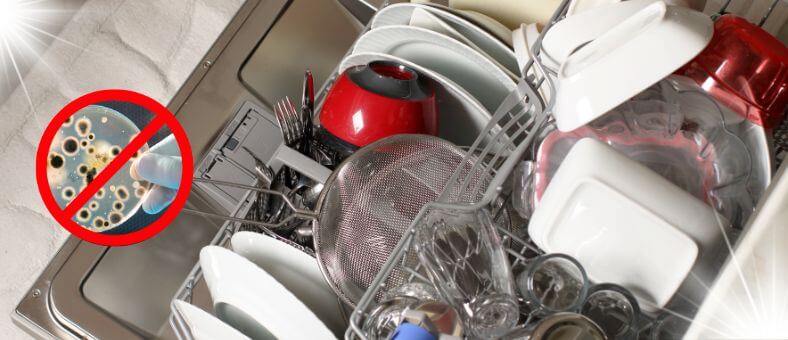
Dishwashers typically use much hotter water than our hands can withstand, providing better sanitization. Most dishwashers have a ‘sanitize’ option designed to kill nearly 100% of bacteria on dishes. On the other hand, while hand washing can effectively clean dishes, it might not kill all bacteria unless you use boiling water and a sufficient amount of soap.
Fact Check
Dishwashers can heat water up to 140-145°F (60-63°C) for optimal cleaning and sanitization, far hotter than the recommended hand washing temperature of 110°F (43°C).
Environmental Implications: Carbon Footprint Analysis
Both hand washing and using a dishwasher have environmental implications. While dishwasher manufacturing and disposal have ecological costs, their efficient water and energy use can offset this over time, making them a part of Eco-friendly dishwashing solutions. Hand washing, with its higher water and energy usage, tends to have a larger carbon footprint per wash, but it avoids the manufacturing and disposal impact. Choosing an energy and water-efficient dishwasher and using it fully loaded and in an eco-friendly setting can minimize your carbon footprint.
Cost Implications: Initial Investment and Running Costs
When considering costs, dishwashers have a higher initial investment than sinks, sponges, and dish soap. However, the running costs can be lower due to the efficient use of water and energy, potentially saving you money in the long term. Hand washing has lower start-up costs but can lead to higher utility bills due to greater water and energy consumption.
Key Point
Consider the lifetime costs, not just the initial price, when deciding between hand washing and using a dishwasher. Factor in your personal time, too – time is money, after all!
Versatility and Capacity: Comparing Volume and Dish Types
When it comes to versatility and capacity, dishwashers and hand washing, both have their strengths and limitations. Dishwashers can handle a larger volume of dishes simultaneously, making them a convenient choice for big families or after-dinner parties. However, not all items are dishwasher safe, and large or awkwardly-shaped items may not fit well.
If you’re considering a new dishwasher, understanding the different options available and Choosing the Right Dishwasher Size is crucial to accommodate your dishwashing needs.
Hand washing, on the other hand, allows for careful cleaning of various types of dishes and cookware, including those unsuitable for the dishwasher. However, handling many dishes in one go might be challenging.
Comfort and Ease: The Ergonomics of Washing Dishes
Consider the physical effort involved in both methods. Hand washing requires standing, scrubbing, and bending over the sink, which can strain the back and hands over time. Dishwashers offer more comfort, requiring only loading and unloading at a comfortable height. This makes dishwashers an excellent choice for people with mobility issues or chronic pain.
Ergonomics isn’t just about physical comfort. It can have long-term effects on your health. So, consider this aspect when choosing your preferred dishwashing method.
The Role of Modern Technology: Smart Dishwashers
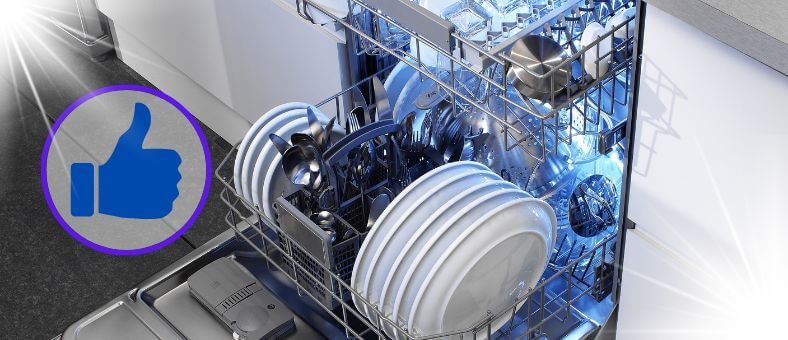
The advent of innovative technology has revolutionized dishwashing. Modern dishwashers have advanced features such as soil sensors to adjust the wash cycle, quiet operation modes, and energy-efficient settings. Some even have Wi-Fi connectivity, allowing you to remotely control and monitor the dishwasher using a smartphone.
Did You Know?
Some smart dishwashers can even order detergent automatically when running low, thanks to integration with services like Amazon Dash Replenishment.
Making the Right Choice for Your Home and Lifestyle
Choosing between a dishwasher and hand washing depends on factors such as your daily routine, the number of dishes you use, your environmental concerns, and your budget. A dishwasher might be a good fit if you entertain frequently or have a large family. However, hand washing could be more practical and economical if you live alone or with another person.
Smart Move
Early 20th-century homemakers had to combat mold using only essential soap and water. Today, we’ve got advanced detergents and fungicides. How lucky are we?
Dishwashing Innovations: A Peek into the Future
The future of dishwashing looks bright, with new technologies on the horizon. Innovations like ultra-efficient water jets, improved filtration systems, and AI-powered dishwashers that can sort and store dishes are in development. These advancements promise to make dishwashing more efficient, convenient, and environmentally friendly.
With the pace of technological advancement, who knows what the future holds? The dishwashing debate may be a thing of the past as we move towards more sustainable and convenient solutions.
The Final Rinse: Dishwasher vs Hand Washing
Hey, what a ride, right? Dive deep into the dishwashing world, and you’ll unearth gold – the kind that helps you make smart, eco-friendly, and efficient choices! Both hand washing and dishwashing have unique strengths tailored to various lifestyles and needs. But here’s the golden nugget: If you value time, energy efficiency, and modern convenience, investing in a reliable dishwasher might just be your game-changer. After all, who doesn’t want an easier life with squeaky-clean dishes at the touch of a button? So, why wait? Make the switch, embrace innovation, and celebrate every dish done right!
At WashDryDazzle, we’re dedicated to providing essential insights that make your daily chores effortless. Dive deeper into our comprehensive Dishwasher Education hub to learn more.
8 Signs You Need to Upgrade Your Dishwasher

Have you ever paused mid-rinse, staring at your dishwasher, and wondered, “Is it time for an upgrade?” Let’s satisfy that burning curiosity: A dishwasher is not just about cleaning dishes; it embodies efficiency, technology, and modern-day convenience. But like all good things, they have their expiry. And sometimes, it’s more obvious than a breakdown.
Introducing “8 Signs You Need to Upgrade Your Dishwasher” – a comprehensive guide to understanding the subtle hints your machine might be giving you. From the unexpected noises it makes to the spike in your utility bills, these indicators can be easy to overlook but are essential in maintaining an efficient kitchen routine.
So, are you ready to dive into the world of old and new dishwashers and find out if yours still makes the cut? Stick around, and let’s decode those telltale signs together. Because knowing when to upgrade can save you time, money, and a lot of dish-related distress in the future!
#1. Inconsistent Cleaning
Ever opened up your dishwasher, excited to pull out sparkling clean dishes, only to be met with stubborn food particles still clinging on? Inconsistent cleaning is often the first red flag. Wondering why? How Dishwashers Work can shed some light. If your dishes don’t come out as pristine as they once did, you might want to check How to Load Your Dishwasher Properly. Even after ensuring they’re properly spaced and the right detergent is used, and the results aren’t up to par, your dishwasher might hint at an upgrade. Limescale build-up or faulty spray arms could be the culprits. But, if a thorough cleaning doesn’t solve the problem, it might be time to bid your old friend goodbye.
#2. Strange Noises
Dishwashers, like most machines, have their unique hums and buzzes. However, if you start hearing strange, unfamiliar noises—like loud clanks, growls, or high-pitched whines—it’s a sign something’s amiss. It might be a loose impeller or a failing motor. While occasional noises can be chalked to a stray spoon or fork, consistent odd sounds should grab your attention. A peaceful kitchen is happy, and strange dishwasher noises don’t fit that picture!
#3. Old Age
Let’s face it: nothing lasts forever. On average, a good-quality dishwasher serves faithfully for about 10 years. If yours is inching closer to a decade or surpassing it, consider giving it a well-deserved retirement. Technological advances mean newer models are more energy-efficient, environmentally friendly, and often have smart features. Upgrading based on age isn’t just about preventing breakdowns but embracing modern efficiency.
#4. Frequent Repairs
A repair here and there is par for the course, but it’s an evident sign if your technician is on speed dial because your dishwasher constantly acts up. Frequent repairs inconvenience your daily routine and become uneconomical in the long run. Why drain your wallet fixing an aging machine when you could invest in a newer, more reliable model? Consistent hiccups are your dishwasher’s saying, “Maybe it’s time for something new.
#5. Higher Utility Bills
When you start noticing an unexplained hike in your monthly utility bills, your trusty dishwasher could be the undercover culprit. As dishwashers age, they might consume more water and electricity to achieve the same results, significantly impacting your monthly expenses. Wondering how much power they might consume? Check out How Much Electricity Does A Dishwasher Use?. Comparing newer models’ energy efficiency with your current one might leave you startled at potential savings. Switching to an energy-efficient unit isn’t just about cost savings; it’s also a step towards a greener footprint.
#6. Visible Rust and Wear
Beauty might be skin deep, but what’s on the outside counts, too, when it comes to appliances. If you see visible rust spots, cracks, or significant wear and tear, it’s more than just an eyesore. These are signs of aging and potential internal issues waiting to surface. Plus, rust inside the unit could even contaminate your dishes. Before you think of replacing your old dishwasher, it’s essential to dispose of it responsibly. Wondering how? Here’s a guide on How to Dispose of and Recycle a Dishwasher. Investing in a new dishwasher isn’t just about aesthetics; it’s about ensuring hygiene and functionality.
#7. Poor Draining
Nothing’s more frustrating than opening your dishwasher door and finding a murky pool of water at the bottom. Poor draining can be due to clogs, faulty pumps, or worn-out seals, indicating that your dishwasher’s performance is compromised. Persistent water stagnation can also be a breeding ground for mold and bacteria. Instead of repeatedly diving in to clean up the mess, it might be time to dive into the market for a replacement.
#8. Outdated Features
Dishwasher technology has seen quite an evolution over the past few years. If your unit still operates with dials in a touchscreen era or needs water-saving and advanced cleaning features that newer models boast, you must catch up. Newer dishwashers not only come with quiet operation but also smart features like connectivity that elevates your dishwashing game. Curious about what a modern dishwasher can do? Dive into this What Is a Smart Dishwasher? article. Upgrading isn’t just about keeping up with the Joneses—it’s about enhancing your kitchen experience.
Dishwasher’s Change Alert
Your dishwasher is more than just an appliance; it’s a kitchen companion that ensures your utensils are spotless and ready for the next meal. However, like all good things, its efficient days might be numbered. From the annoying hums and bangs to the sudden surge in utility bills or visible wear and tear, these are signals nudging you toward an upgrade. Modern dishwashers promise advanced features, energy efficiency, and smarter cleaning.
If your dishwasher is displaying any of these eight signs, it might be whispering (or, perhaps, loudly declaring) that it is time for a retirement party. Embrace the change and give your kitchen a machine in tune with the times. After all, every dish deserves the sparkling finish of a top-notch dishwasher.
Ready for an Upgrade? Here Are Our Top Dishwasher Picks
If your dishwasher is showing any of the signs above, it may be time to say goodbye to the old and hello to something better. To make your decision easier, we’ve handpicked the best portable and built-in dishwashers that combine powerful performance, modern features, and energy efficiency—all tried, tested, and reviewed on WashDryDazzle.
- Explore Built-In Dishwasher Reviews
- Explore Portable Dishwasher Reviews
- Explore Countertop Dishwasher Reviews





